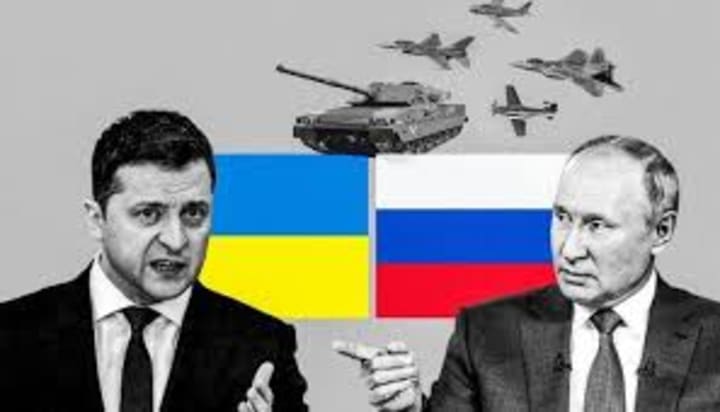Russia vs Ukraine War and How it Affects us
Debunking The Myth: Why Russia And Ukraine Are Not Really At War: A blog about the conflict in Ukraine.

Introduction
The conflict between Russia and Ukraine has been ongoing since 2014, with tensions escalating to a full-blown war in Eastern Ukraine. This article will explore the history of the conflict, its causes, the parties involved, and its impact on the region and beyond.

Background
The roots of the conflict can be traced back to the Soviet era, when Ukraine was a part of the Soviet Union. Following the collapse of the Soviet Union, Ukraine became an independent state in 1991. However, it remained closely tied to Russia economically, politically, and culturally. The two countries maintained strong trade and energy ties, and Russian was widely spoken in Ukraine, particularly in the east.
In 2013, Ukraine was facing a major crisis as its government under President Viktor Yanukovych was accused of corruption and human rights abuses. Yanukovych was also seen as leaning towards Russia and away from closer ties with the European Union (EU). This led to protests across the country, with demonstrators demanding Yanukovych's resignation and closer ties with the EU.
In February 2014, Yanukovych was overthrown in a popular uprising, known as the Maidan Revolution. A pro-Western government was installed, and Ukraine signed an association agreement with the EU. However, this move was seen as a threat by Russia, which had long regarded Ukraine as within its sphere of influence. Russia responded by annexing Crimea, a region of Ukraine with a significant Russian-speaking population, and supporting separatist rebels in eastern Ukraine.
Causes
The causes of the conflict are complex and multifaceted. At its core, it is a battle for influence and control in the region. Russia sees Ukraine as a crucial buffer zone between itself and NATO, the Western military alliance. It also views Ukraine as a vital part of its historical and cultural sphere of influence.
For Ukraine, the conflict is about preserving its independence and territorial integrity. The Ukrainian government sees the Russian intervention as an illegal and aggressive act aimed at undermining its sovereignty. It also fears that if the conflict continues, it could lead to further Russian encroachment on its territory.
Another factor in the conflict is the question of national identity. Ukraine has long struggled to define itself as a nation, with a population divided between those who identify as Ukrainian and those who see themselves as Russian or ethnically Russian. This divide is particularly pronounced in the east of the country, where many people speak Russian as their first language and have closer ties to Russia than to Ukraine.
The Parties Involved
The conflict involves several parties, including Ukraine, Russia, and the separatist rebels in eastern Ukraine. The Ukrainian government is backed by the West, particularly the United States and the European Union. The Russian government supports the separatists and has been accused of sending troops and weapons into Ukraine.
The separatist rebels are made up of a mix of local residents and Russian fighters. They control several areas in eastern Ukraine, including the Donetsk and Luhansk regions. They have declared themselves to be independent states, known as the Donetsk People's Republic (DPR) and the Luhansk People's Republic (LPR).
Impact
The conflict has had a devastating impact on Ukraine, particularly in the east of the country. Thousands of people have been killed, and many more have been displaced from their homes. The economy has suffered, with many businesses forced to close or relocate. The conflict has also had a humanitarian impact, with shortages of food, water, and medical supplies.
The conflict has also had wider regional and global implications. It has led to a deterioration in relations between Russia and the West, with both sides imposing economic sanctions on each other. The conflict has also contributed to the rise of nationalist and populist movements in Europe and the United States. It has also increased tensions between Russia and Ukraine.
Steps Taken to Resolve the Conflict
Efforts to resolve the conflict have been ongoing since it began in 2014. The following are some of the steps that have been taken:
Minsk Agreements: In 2015, the Ukrainian government, Russia, and the separatist rebels signed the Minsk agreements, aimed at ending the conflict. The agreements called for a ceasefire, the withdrawal of heavy weapons, and the establishment of a special status for the Donetsk and Luhansk regions. However, the agreements have not been fully implemented, and fighting has continued.
Diplomatic Talks: There have been numerous rounds of diplomatic talks aimed at resolving the conflict, including talks held under the auspices of the Organization for Security and Cooperation in Europe (OSCE). However, progress has been slow, with both sides accusing the other of failing to implement agreements reached in talks.
Economic Sanctions: The United States and the European Union have imposed economic sanctions on Russia in response to its actions in Ukraine. These sanctions have had a significant impact on the Russian economy, but they have not succeeded in changing Russia's behavior in Ukraine.
Peacekeeping Mission: There have been calls for a UN peacekeeping mission to be deployed in eastern Ukraine to help enforce the Minsk agreements and end the fighting. However, there has been disagreement over the scope and mandate of such a mission, and it has not been deployed.
Challenges to Resolving the Conflict
Resolving the conflict between Russia and Ukraine is a complex and challenging task. The following are some of the main challenges:
Lack of Trust: There is a deep lack of trust between Russia and Ukraine, which has made it difficult for them to reach a lasting peace agreement. Both sides accuse the other of bad faith and failing to honor agreements reached in talks.
Role of Separatists: The separatist rebels in eastern Ukraine are a key factor in the conflict, and they have their own agenda. They are supported by Russia, but they also have their own interests and demands, which may not align with those of the Ukrainian government.
Nationalism and Identity: The conflict is driven in part by questions of national identity and ethnicity. Both Russia and Ukraine see themselves as defending their national interests, which has made it difficult to find a compromise that satisfies both sides.
Geopolitical Tensions: The conflict between Russia and Ukraine has broader geopolitical implications, particularly for relations between Russia and the West. This has made it difficult to find a solution that satisfies all parties involved.
Conclusion
The conflict between Russia and Ukraine has been ongoing since 2014 and shows no signs of ending. The conflict has had a devastating impact on Ukraine, and it has contributed to a deterioration in relations between Russia and the West. Despite numerous efforts to resolve the conflict, progress has been slow, and the challenges are significant. Finding a lasting solution to the conflict will require compromise, trust-building, and a willingness to put the interests of the people of Ukraine first.






Comments
There are no comments for this story
Be the first to respond and start the conversation.